Blog Page
The Privilege of Being a Certified Translator

In the world of language and communication, I consider myself incredibly fortunate to be a certified translator. This profession grants me the privilege of bridging linguistic gaps and connecting people from different corners of the globe. Every day, I have the opportunity to delve into the intricate beauty of languages, unravel cultural intricacies, and convey messages with precision and clarity.
Beyond Translation: The Hidden Humour of Certified Translators

When we think of certified translators, we often envision individuals immersed in the serious business of language and communication. Some think they are walking dictionaries. While accuracy and professionalism are indeed integral to their work, what many fail to realize is that certified translators also possess a remarkable sense of humour. I know I do! In this blog, we will explore how certified translators infuse humour into their translations, demonstrate creativity in dealing with linguistic challenges, and find joy in their linguistic endeavours.
Wordplay and Puns
Certified translators possess a deep understanding of the intricacies of language, allowing them to appreciate and utilize wordplay and puns in their translations. They possess a keen eye for linguistic nuances and cleverly adapt puns or play on words from one language to another, ensuring that the humour remains intact. This skill is particularly evident in the translation of advertisements, marketing campaigns, or comedic content where humour and wit play a crucial role in engaging the audience. I enjoy reading translations from English to French from the Canadian store Giant Tiger. Their translators are witty. As a certified translator, I think my sense of humour and my experience in marketing would blend well with their translation culture!
Read more: Beyond Translation: The Hidden Humour of Certified Translators
Skills Required to Become a Certified Translator: Unlocking the Linguistic Pathway

Becoming a certified translator is an exciting and rewarding career choice for those passionate about languages and communication. While linguistic proficiency is a fundamental requirement, the skills needed to excel in this profession extend beyond mere language fluency. In this blog, we will explore the essential skills required to become a certified translator and how they contribute to successful and impactful translation work.
- Exceptional Language Proficiency
At the core of a certified translator's skill set lies exceptional language proficiency. Fluency in both the source language and the target language is paramount. A deep understanding of grammar, vocabulary, idiomatic expressions, and cultural nuances allows translators to accurately convey meaning and context. Mastery of linguistic subtleties ensures that translations maintain the essence and intention of the original text, enabling effective communication across languages.
Read more: Skills Required to Become a Certified Translator: Unlocking the Linguistic Pathway
nobody controls time, but you can manage how you spend it
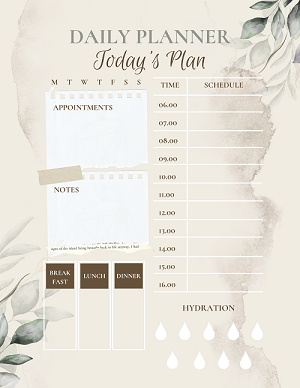
Time is a fascinating subject. As we grow older, we want more of it. If we could just turn back time or at least pause it for a while. Time is fair. Everyone gets the same 24 hours in a day. How you spend your time defines you as an employee, as a manager, as a leader, as a person. Nobody controls time, but you can manage how you spend it.
Managing your schedule requires balance of tasks and decision-making skills. What’s important to you may not be important to someone else. No one can work 24 hours in a day, every day. No one can sleep 24 hours a day, every day. Balance is the key to a happy work life and personal life.
Here’s what you can do if you wish to manage your time effectively. Draw a list of all the tasks that you need and want to accomplish today. Categorize your tasks and break down your schedule with segments of strong to weak obligation modals:
- MUST do today (it’s your responsibility, like priorities at work and the essentials at home, e.g. meals, sleep, taking care of children, etc.)
- SHOULD do today (important, but can be done another day)
- WANT to do today (the fun stuff)
Read more: nobody controls time, but you can manage how you spend it
Nothing Beats Music and Birds

When I translate, I like to listen to music. The type of music depends on my mood, the time of day, the workload, etc. When I’m overly tired and have a difficult time concentrating, I always put on classical music with birds singing in the background. This helps me focus, relax and be more productive.
Many studies have shown that listening to classical music decreases blood pressure, boosts memory, ignites creativity, and improves brain function. Other studies have demonstrated that listening to the sounds of birds chirping reduces anxiety, lowers stress levels, and creates positive emotions. Imaging combining them!
Did you know that combining classical music with the sounds of birds chirping has more benefits than listening to each individually?
The Ivy Lee Productivity Method
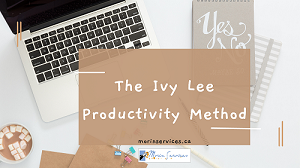
I am fascinated by ways to increase my productivity at work and at home. I like to search the Web for methods or techniques, and I love to try them out. I was intrigued by the Ivy Lee Productivity Method. In my research, it said that this method is very simple and can be adapted to most workplace environments.
Here’s how it works. My work week starts on Monday, but you can start on any workday.
- On Sunday, write down the six most important tasks to do on Monday.
- Assign numbers from 1 to 6 to each task (1 is the most important task).
- On Monday, start with task 1. When you are done task 1, proceed to task 2. Do not start task 2 before you are done task 1. Continue doing your tasks, one at a time, throughout your day.
- At the end of the day, write another set of six tasks for the following day.
- Do the same every day for the rest of the work week.
Here’s what I thought I would write in this blog.
The Pomodoro Technique
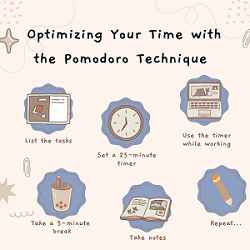
I recently decided to try the Pomodoro technique and I am quite pleased.
As a certified translator, I sometimes work for hours on end. Eventually, I get distracted and am no longer effective. The Pomodoro technique helps me to focus and be more productive. It was first developed in the late 1980s by Francesco Cirillo. This time management method encourages you to work in timed intervals. Each work session lasts 25 minutes and is followed by a five-minute break. It’s very simple to use and quite effective.
There are many Pomodoro timers on YouTube. I particularly enjoy this study ambience video. https://www.youtube.com/watch?v=Trf_8txJl6M
How to Tackle All Your Tasks in One Day!

It’s Monday morning. You know it will be a busy day. How do you organize your day? There are different strategies you can use to organize your day and make sure that you complete all your tasks. Here are some of my tips.
- The List Maker
What does your list look like? Where is your list? Is your list organized? Is your list neat or all messy? Here are different kinds of lists that you can make:
- The traditional: Your list is written on a lined sheet of paper.
- The board: Your list is written on a white board.
- The sticky: Each task is written on separate sticky notes that you stick on the wall or you pin on a board.
- The techy: Your list is typed in Excel or in Word.
- The cell: Your list is voiced in or written as notes on your cell.
At this point, it doesn’t matter what kind of list you make, so long as you have one. I like to use more than one.
- The Decision Maker
Now come the important questions.
A Sit-Stand Desk Has Allowed Me to Be Healthier and More Productive
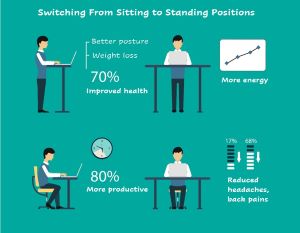
This year, I converted my office desk into a sit-stand desk. Wow! I don’t know why I waited so long to update my workstation!
As a translator, I work long hours on a computer. Sometimes, I am so focused on my work that I neglect my posture until my “everything” hurts.
Now that I have a sit-stand desk, I am so much more productive. I no longer have work-related aches (headaches, back aches, soar buttocks, etc.). Here are the benefits I noticed since I switched to an adjustable desk.
Read more: A Sit-Stand Desk Has Allowed Me to Be Healthier and More Productive
Take Your Work Outside!

How to Set Up an Outdoor Home Office
We all know the numerous benefits of spending time outside. It can reduce stress, improve your mood, boost your energy, and stimulate your creativity. As more and more people are working from home, it is important to keep certain things in mind if you want to take advantage of those warm sunny days and still be productive at work.
Here are a few tips to make your outdoor home office as pleasant and efficient as possible.
Focus on Shady Business
Make sure to sit in a well-shaded area, so that you are protected from harmful UV rays. It might also be a good idea to wear sunscreen and long sleeves. If you are squinting to read your emails, you probably need more shade. Consider adjusting the brightness on your screen and moving to a more shaded area. I found that the best shaded area for me was under a pergola. You can pull the canopy fabric on either side of the pergola and adjust it as the sun moves throughout the day.
Quotes and Questions

Would you like Morin Services to provide you with a free quote?
Send an email to This email address is being protected from spambots. You need JavaScript enabled to view it. with a copy of your document that requires translation, revision, editing, etc. Please make sure your document is in Word format. A quote will be sent to you within 48 hours.
Morin Services Uses LogiTerm Pro to Generate Quotes

Morin Services uses a computer-aided translation software that has features that will translate into discounts for your business. This software is called LogiTerm Pro from Terminotix.
LogiTerm Pro has a pretranslation tool that identifies sentences and terms that have already been translated and saved in Morin Services’ archives. This tool allows Morin Services to compare a source document to documents that are most like it and have been previously translated. Then a LogiTrans Analysis Report is generated providing stats for matched sentences and words. Morin Services uses this report to create client quotes.
Read more: Morin Services Uses LogiTerm Pro to Generate Quotes
Get in the Mood... to Work

After a few days or a few weeks of being confined at home, it’s often difficult to go back to work. It’s important to understand the reasons for not wanting to return, but sometimes you don’t have good reasons. You just don’t FEEL like it. And, since apparently all good things must come to an end, so should your time off. Getting in the mood takes more effort for some. So, I’ve decided to share my tips on how to get in the mood to work.
Bring That Warm Fuzzy Feeling to Work
Take a good look at your work environment. Is it bland, uncomfortable, cold, and dreary? No wonder you are not fired up! Set the stage for a productive and inviting work environment. Give your workspace a makeover that will appeal to your senses… all of them!
How to Be a Productive Leader
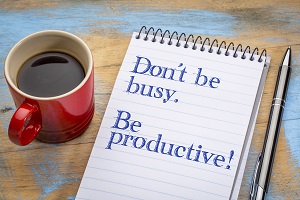
I’m a teacher and LBS program coordinator as well as a small business owner. Because I work two jobs, I want, and I need to be productive. To me, being productive doesn’t mean working harder, it means working smarter to get through my to-do list faster while doing an excellent job. Work smart, work fast, work well. Let me share some of my tips on how to be a productive leader.
Working Smarter
- Look at the Big Picture: Understand and analyze what needs to be done. Decide what is important, what is urgent, what is a priority, and what can be delegated. Know your stuff and make sure your staff members know what is expected of them.
- Organize and Plan: Break up large projects into small tasks and attainable milestones. Organize your time with an agenda, to-do list, daily priority list and use visuals such as Post-its or large dry-erase multi-month calendars. Take time to get organized and stay organized. No matter how busy you are, schedule time to regularly meet with your staff. Make time to listen to their concerns.